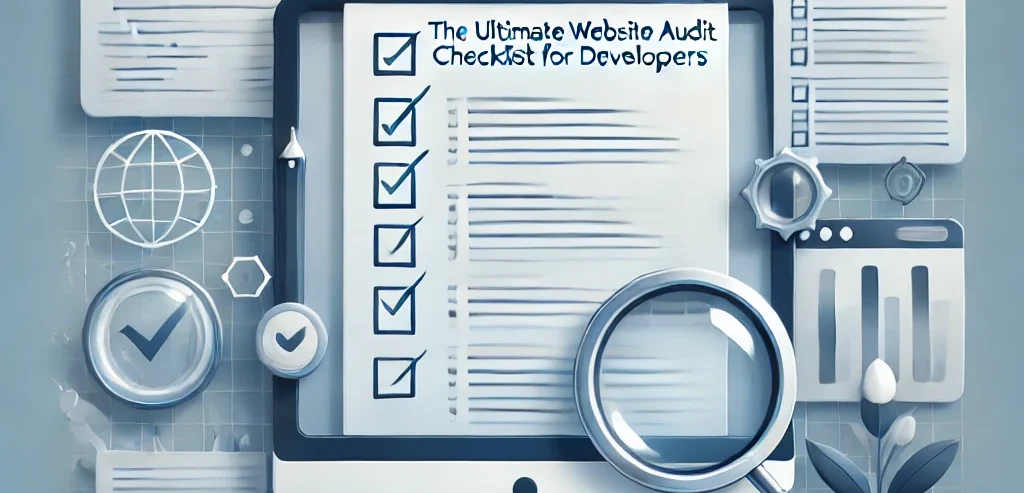Website Audit Checklist for Developers – 2024
As web developers, we know that maintaining a high-quality website involves more than just writing good code. Regular website audits are crucial for ensuring optimal performance, security, and user experience.
Contents
show
In this comprehensive guide, we’ll walk through an essential website audit checklist that every developer should have in their toolkit.
1. Performance Optimization
Page Speed
- [ ] Test page load times using tools like Lighthouse or GTmetrix
- [ ] Optimize image sizes and use modern formats (WebP, AVIF)
- [ ] Implement lazy loading for images and videos
- [ ] Minify and compress CSS, JavaScript, and HTML
- [ ] Leverage browser caching
- [ ] Use a Content Delivery Network (CDN)
Resource Optimization
- [ ] Reduce HTTP requests
- [ ] Optimize critical rendering path
- [ ] Implement code splitting for JavaScript
- [ ] Use asset versioning for better cache control
2. Technical SEO
Indexability
- [ ] Check robots.txt configuration
- [ ] Verify XML sitemap is up-to-date and submitted to search engines
- [ ] Ensure proper canonical tags are in place
- [ ] Check for crawl errors in Google Search Console
Meta Information
- [ ] Verify all pages have unique title tags and meta descriptions
- [ ] Implement schema markup where appropriate
- [ ] Check for proper heading structure (H1, H2, etc.)
- [ ] Ensure URLs are SEO-friendly
3. Security
SSL/TLS
- [ ] Verify SSL certificate is valid and up-to-date
- [ ] Implement HSTS if not already in place
- [ ] Ensure all resources are served over HTTPS
Security Headers
- [ ] Implement Content Security Policy (CSP)
- [ ] Set up X-Frame-Options header
- [ ] Configure X-Content-Type-Options header
- [ ] Add X-XSS-Protection header
Authentication & Data
- [ ] Review password policies
- [ ] Implement rate limiting for login attempts
- [ ] Ensure secure session handling
- [ ] Verify data encryption practices
4. Accessibility
WCAG Compliance
- [ ] Test color contrast ratios
- [ ] Ensure all images have alt text
- [ ] Verify proper heading structure for screen readers
- [ ] Check keyboard navigation functionality
General Accessibility
- [ ] Implement ARIA labels where necessary
- [ ] Ensure forms are accessible
- [ ] Test with screen readers
- [ ] Verify text resize functionality
5. Mobile Responsiveness
- [ ] Test on multiple devices and screen sizes
- [ ] Check for proper viewport configuration
- [ ] Ensure touch targets are appropriately sized
- [ ] Verify readable font sizes on mobile devices
6. Code Quality
Frontend
- [ ] Validate HTML
- [ ] Check for CSS specificity issues
- [ ] Verify JavaScript console for errors
- [ ] Review code commenting and documentation
Backend
- [ ] Check for outdated dependencies
- [ ] Review API endpoint performance
- [ ] Verify error handling and logging
- [ ] Assess database query optimization
7. User Experience
- [ ] Test all forms and interactive elements
- [ ] Verify broken links
- [ ] Check 404 page functionality
- [ ] Ensure consistent navigation across the site
8. Analytics and Monitoring
- [ ] Verify analytics tracking is working correctly
- [ ] Set up error tracking and monitoring
- [ ] Implement performance monitoring
- [ ] Check and analyze user behavior flows
Tools for Website Auditing
Performance Testing
SEO Analysis
Security Scanning
Accessibility Testing
Implementing the Audit
To make the most of this checklist:
- Schedule regular audits (quarterly is recommended)
- Prioritize issues based on impact and effort required
- Document all findings and actions taken
- Create a roadmap for implementing improvements
- Consider automating parts of the audit process
Conclusion
A thorough website audit is essential for maintaining a high-quality web presence. By regularly going through this checklist, you can ensure your website remains performant, secure, and user-friendly.
Remember, website maintenance is an ongoing process, and regular audits help you stay ahead of potential issues while keeping your site in top condition.


Comments
Comments are disabled for this post